 This illustration shows China's Tianwen 1 robotic probe entering Martian orbit on Feb 10, 2021. (PHOTO PROVIDED TO CHINADAILY.COM.CN)
This illustration shows China's Tianwen 1 robotic probe entering Martian orbit on Feb 10, 2021. (PHOTO PROVIDED TO CHINADAILY.COM.CN)
BEIJING - Precise braking near Mars helped China's Tianwen 1 probe to successfully enter the orbit around the red planet on Wednesday, according to the country's space scientists.
Yang Yuguang, a researcher with China Aerospace Science and Industry Corporation Limited, told the Science and Technology Daily that the braking operation is a key and risky step in the Mars exploration mission, which requires a high degree of accuracy.
ALSO READ: Tianwen 1 1st Chinese spacecraft to Mars
If Tianwen 1 brakes in an orbit too close to Mars, the probe may collide with the planet's surface, and if the braking time is too long, which results in excessive braking force, the probe will also face the risk of crashing, said Yang Yuguang, a researcher with China Aerospace Science and Industry Corporation Limited
When a probe is set to be captured by a planet's gravity, the lower its orbit is, the more fuel the engine will save. If Tianwen 1 brakes in an orbit too close to Mars, the probe may collide with the planet's surface, given that minor errors may exist in its position measurement and control, Yang said.
If the braking time is too long, which results in excessive braking force, the probe will also face the risk of crashing, he said.
"Only when the braking operation is performed with precise timing and duration can the probe successfully enter the planet's orbit," said Pang Zhihao, an expert on deep space exploration technologies.
The deceleration of Tianwen 1 started with a 3000N engine ignited at 7:52 pm (Beijing time) on Wednesday. After about 15 minutes, the spacecraft, including an orbiter, a lander and a rover, had slowed enough to be captured by Mars' gravity and entered an elliptical orbit around the red planet, with its closest distance from the Martian surface at about 400 kilometers, according to the China National Space Administration.
READ MORE: China's Tianwen 1 probe enters Mars orbit
Braking near Mars is different from braking near the moon, which China's lunar probes have successfully achieved in previous lunar missions.
The average distance between Earth and the moon is about 384,400 km, and the communication delay is only about one second. But the distance between Earth and Mars is more than 180 million km, and the one-way communication delay is more than 10 minutes.
"In this case, the ground cannot monitor the spacecraft in real time. Instructions needed to be transmitted in advance and executed independently by the spacecraft," Yang explained.
But slight deviations in the engine thrust and different variables concerning the spacecraft's position, speed and attitude will all add to the complexity of achieving autonomous control, he said, adding that to ensure smooth autonomous control, Tianwen 1 is equipped with multiple sensors to allow for the accurate measurement of flight conditions.
With a weight of more than 5 tonnes, Tianwen 1 is among the world's heaviest planetary probes. But scientists and engineers have managed to equip it with a relatively small engine so as to leave more weight and space for payloads. To make up for the small thrust, they extended the braking time to meet the braking requirements, Yang said.


